Healthcare Acquired Infections in New Zealand
VerifiedAdded on 2023/06/03
|13
|1459
|291
AI Summary
This presentation discusses the causes, impact, and control of healthcare acquired infections (HAIs) in New Zealand. It covers the various microorganisms responsible for HAIs, the impact of HAIs on patients, staff, and facilities, and the control of urinary tract infections. Additionally, it explores the role of antimicrobial stewardship in preventing HAIs and the objectives of AMS in New Zealand. The presentation cites various studies and reports to support its claims.
Contribute Materials
Your contribution can guide someone’s learning journey. Share your
documents today.

Healthcare acquired infections in
New Zealand
Name
Institution
Course
Date
New Zealand
Name
Institution
Course
Date
Secure Best Marks with AI Grader
Need help grading? Try our AI Grader for instant feedback on your assignments.
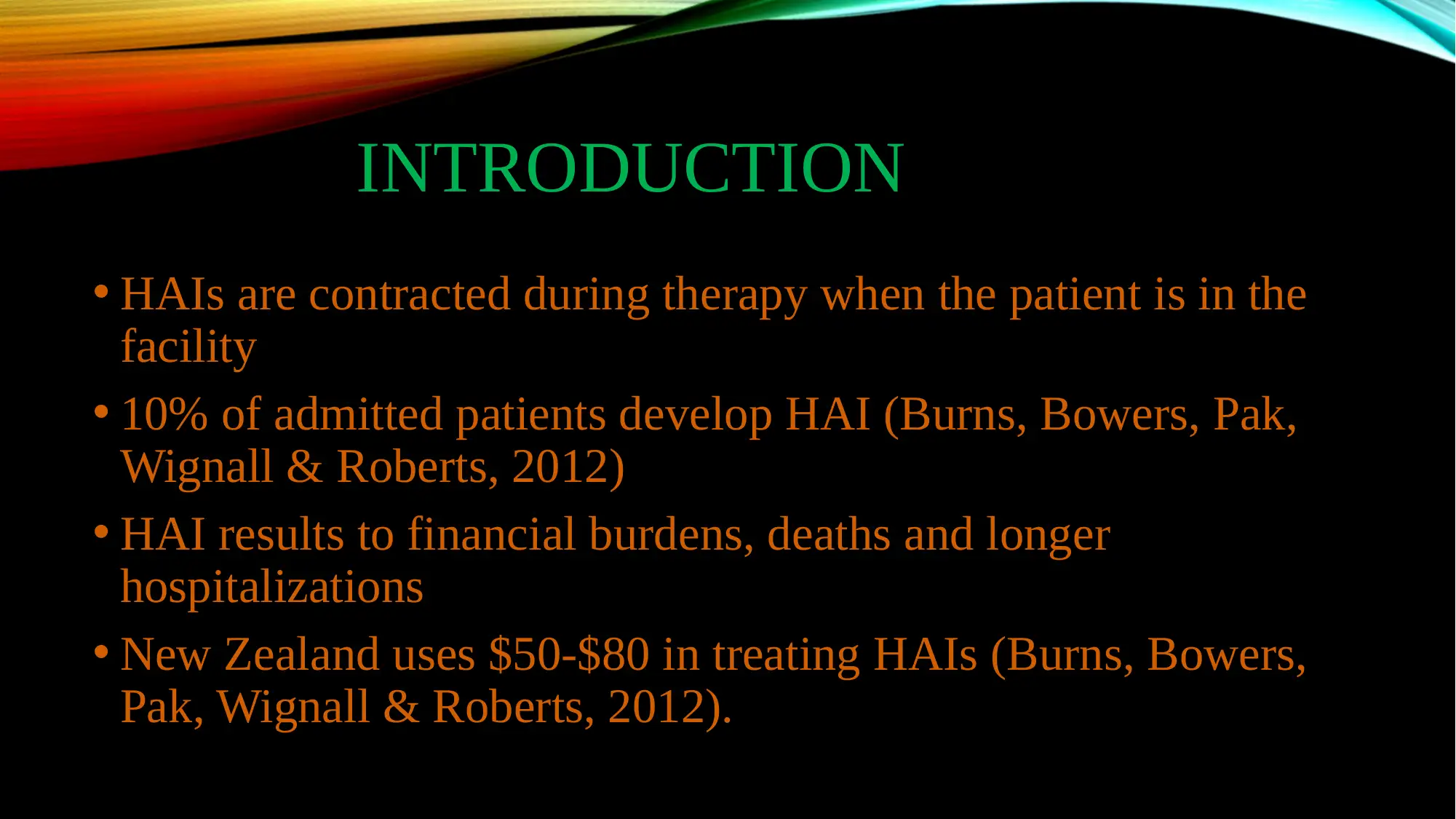
INTRODUCTION
• HAIs are contracted during therapy when the patient is in the
facility
• 10% of admitted patients develop HAI (Burns, Bowers, Pak,
Wignall & Roberts, 2012)
• HAI results to financial burdens, deaths and longer
hospitalizations
• New Zealand uses $50-$80 in treating HAIs (Burns, Bowers,
Pak, Wignall & Roberts, 2012).
• HAIs are contracted during therapy when the patient is in the
facility
• 10% of admitted patients develop HAI (Burns, Bowers, Pak,
Wignall & Roberts, 2012)
• HAI results to financial burdens, deaths and longer
hospitalizations
• New Zealand uses $50-$80 in treating HAIs (Burns, Bowers,
Pak, Wignall & Roberts, 2012).
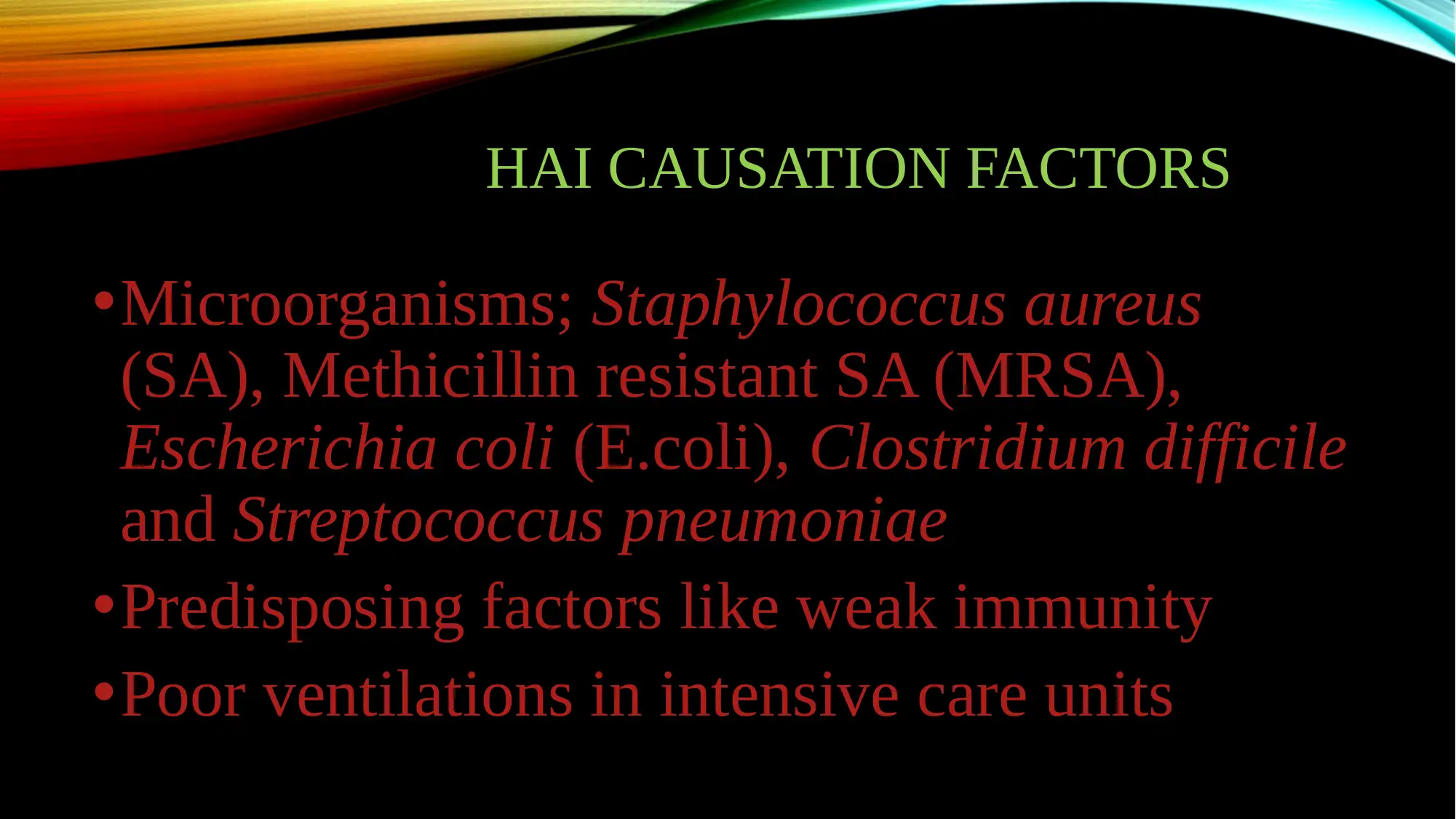
HAI CAUSATION FACTORS
•Microorganisms; Staphylococcus aureus
(SA), Methicillin resistant SA (MRSA),
Escherichia coli (E.coli), Clostridium difficile
and Streptococcus pneumoniae
•Predisposing factors like weak immunity
•Poor ventilations in intensive care units
•Microorganisms; Staphylococcus aureus
(SA), Methicillin resistant SA (MRSA),
Escherichia coli (E.coli), Clostridium difficile
and Streptococcus pneumoniae
•Predisposing factors like weak immunity
•Poor ventilations in intensive care units

SA AND MRSA
• Causes skin and soft skin infections (SSTI), pneumonia,
septic arthritis, osteomyelitis, foreign body infections,
endocarditis and endovascular diseases (Liu et al., 2011)
• Common in hospitals as well as aged care facilities.
• MRSA is resistant all penicillin and beta-lactam
antibiotics (Magiorakos et al., 2012)
• Prevalence rate 10% (Williamson, et al., 2014).
• Infections have increased from 81 to 140 per 10, 000
person between 2000 and 2001 (Williamson et al., 2014)
• Causes skin and soft skin infections (SSTI), pneumonia,
septic arthritis, osteomyelitis, foreign body infections,
endocarditis and endovascular diseases (Liu et al., 2011)
• Common in hospitals as well as aged care facilities.
• MRSA is resistant all penicillin and beta-lactam
antibiotics (Magiorakos et al., 2012)
• Prevalence rate 10% (Williamson, et al., 2014).
• Infections have increased from 81 to 140 per 10, 000
person between 2000 and 2001 (Williamson et al., 2014)
Secure Best Marks with AI Grader
Need help grading? Try our AI Grader for instant feedback on your assignments.
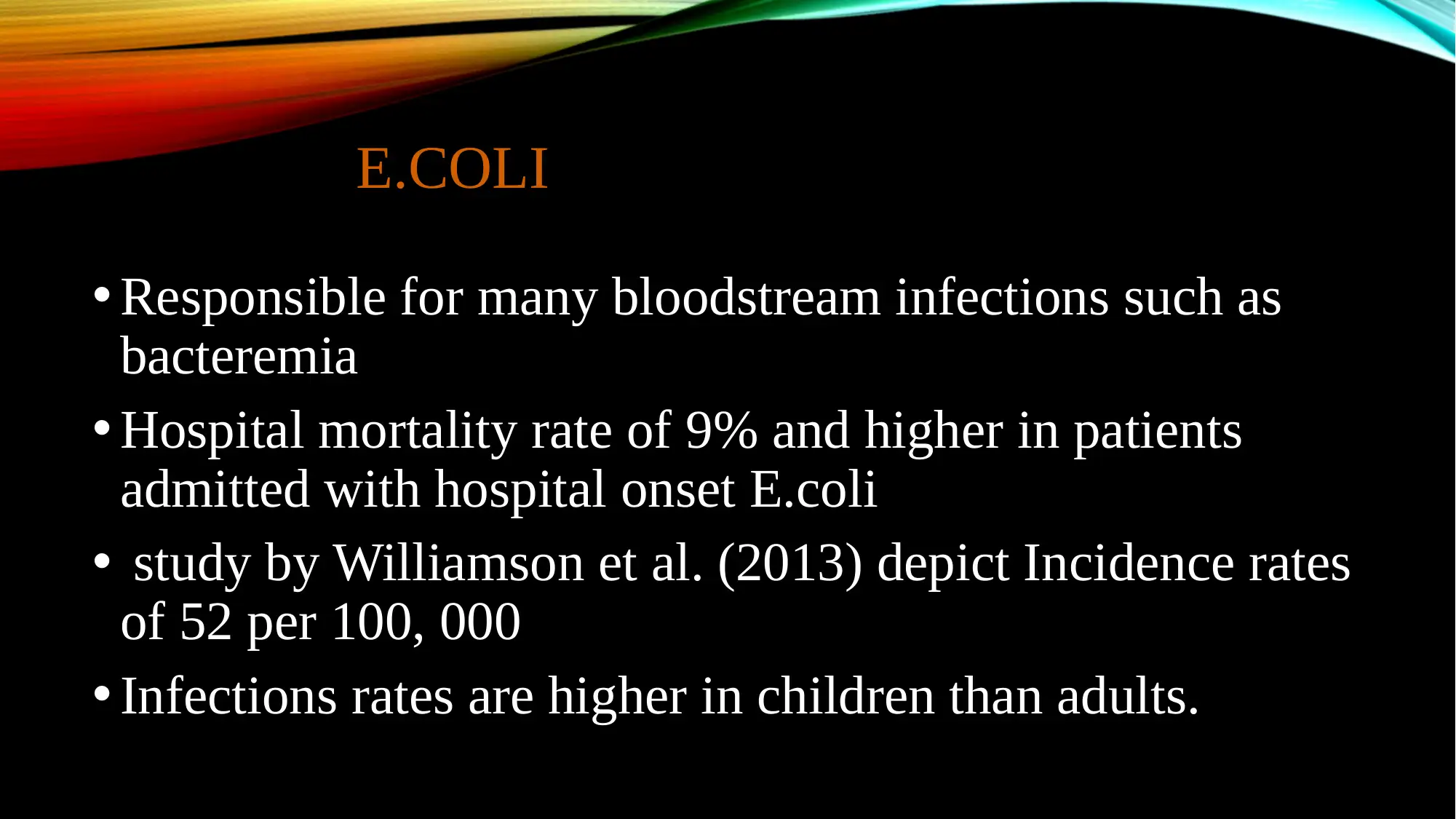
E.COLI
• Responsible for many bloodstream infections such as
bacteremia
• Hospital mortality rate of 9% and higher in patients
admitted with hospital onset E.coli
• study by Williamson et al. (2013) depict Incidence rates
of 52 per 100, 000
• Infections rates are higher in children than adults.
• Responsible for many bloodstream infections such as
bacteremia
• Hospital mortality rate of 9% and higher in patients
admitted with hospital onset E.coli
• study by Williamson et al. (2013) depict Incidence rates
of 52 per 100, 000
• Infections rates are higher in children than adults.
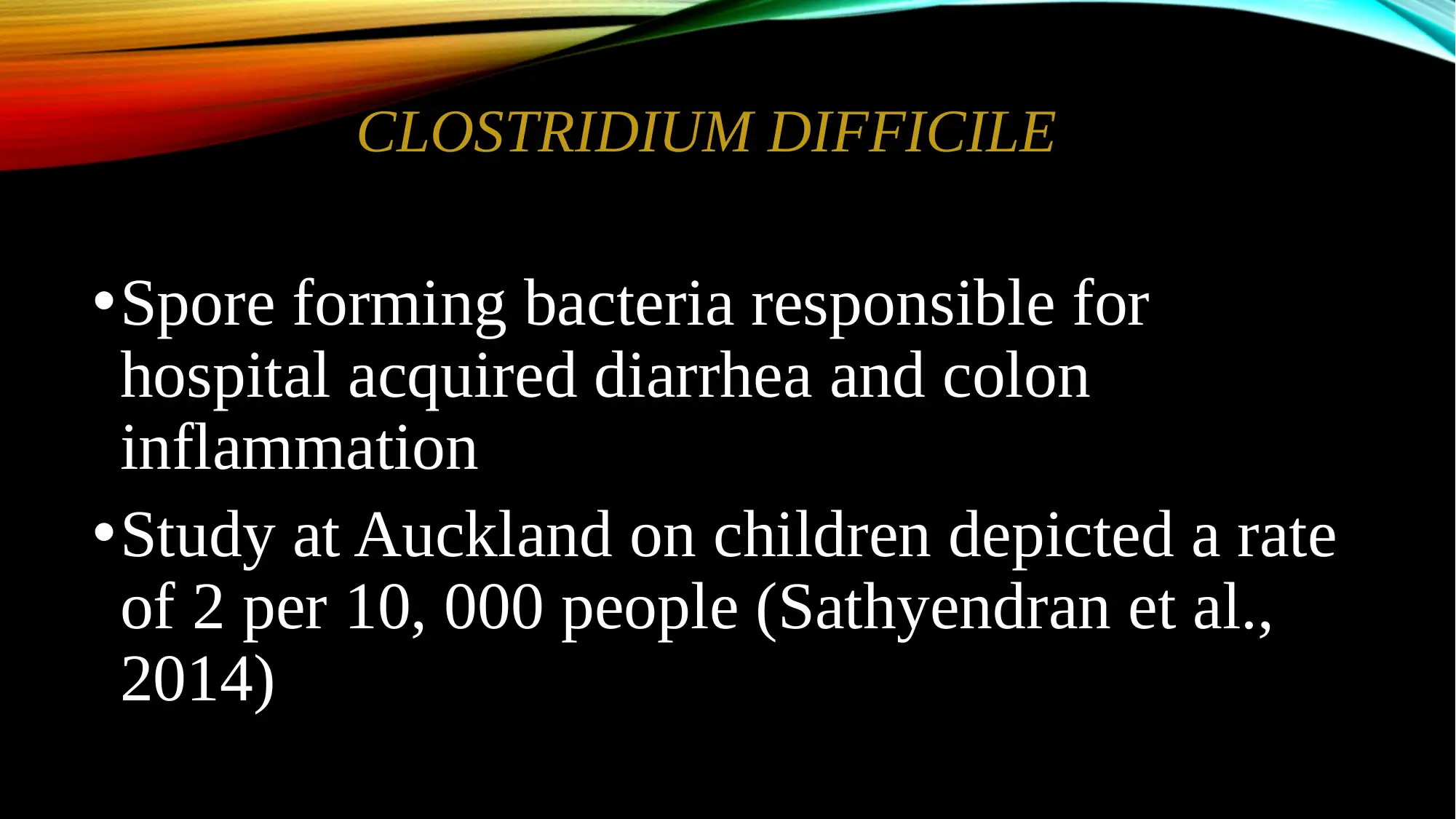
CLOSTRIDIUM DIFFICILE
•Spore forming bacteria responsible for
hospital acquired diarrhea and colon
inflammation
•Study at Auckland on children depicted a rate
of 2 per 10, 000 people (Sathyendran et al.,
2014)
•Spore forming bacteria responsible for
hospital acquired diarrhea and colon
inflammation
•Study at Auckland on children depicted a rate
of 2 per 10, 000 people (Sathyendran et al.,
2014)
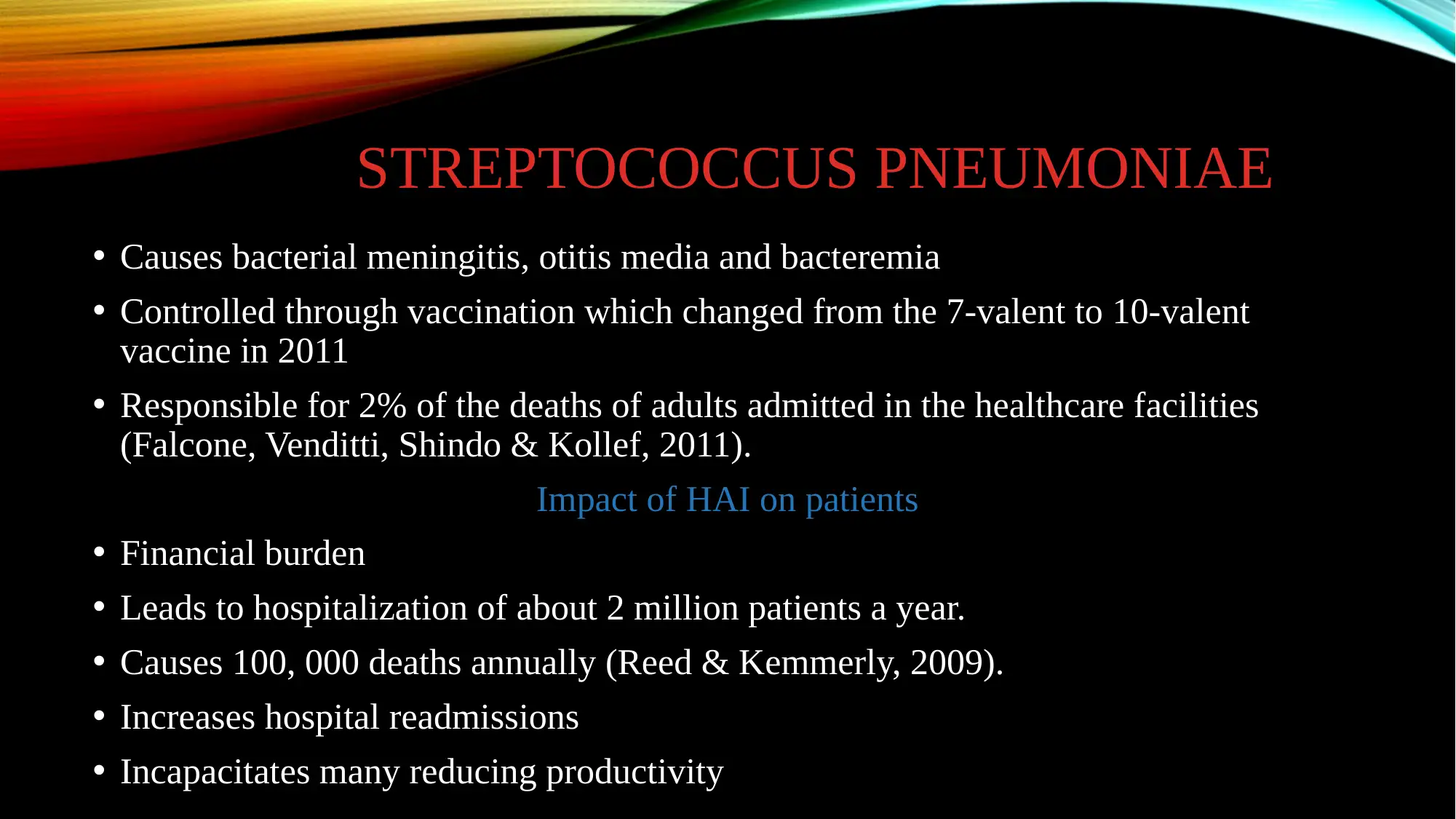
STREPTOCOCCUS PNEUMONIAE
• Causes bacterial meningitis, otitis media and bacteremia
• Controlled through vaccination which changed from the 7-valent to 10-valent
vaccine in 2011
• Responsible for 2% of the deaths of adults admitted in the healthcare facilities
(Falcone, Venditti, Shindo & Kollef, 2011).
Impact of HAI on patients
• Financial burden
• Leads to hospitalization of about 2 million patients a year.
• Causes 100, 000 deaths annually (Reed & Kemmerly, 2009).
• Increases hospital readmissions
• Incapacitates many reducing productivity
• Causes bacterial meningitis, otitis media and bacteremia
• Controlled through vaccination which changed from the 7-valent to 10-valent
vaccine in 2011
• Responsible for 2% of the deaths of adults admitted in the healthcare facilities
(Falcone, Venditti, Shindo & Kollef, 2011).
Impact of HAI on patients
• Financial burden
• Leads to hospitalization of about 2 million patients a year.
• Causes 100, 000 deaths annually (Reed & Kemmerly, 2009).
• Increases hospital readmissions
• Incapacitates many reducing productivity
Paraphrase This Document
Need a fresh take? Get an instant paraphrase of this document with our AI Paraphraser
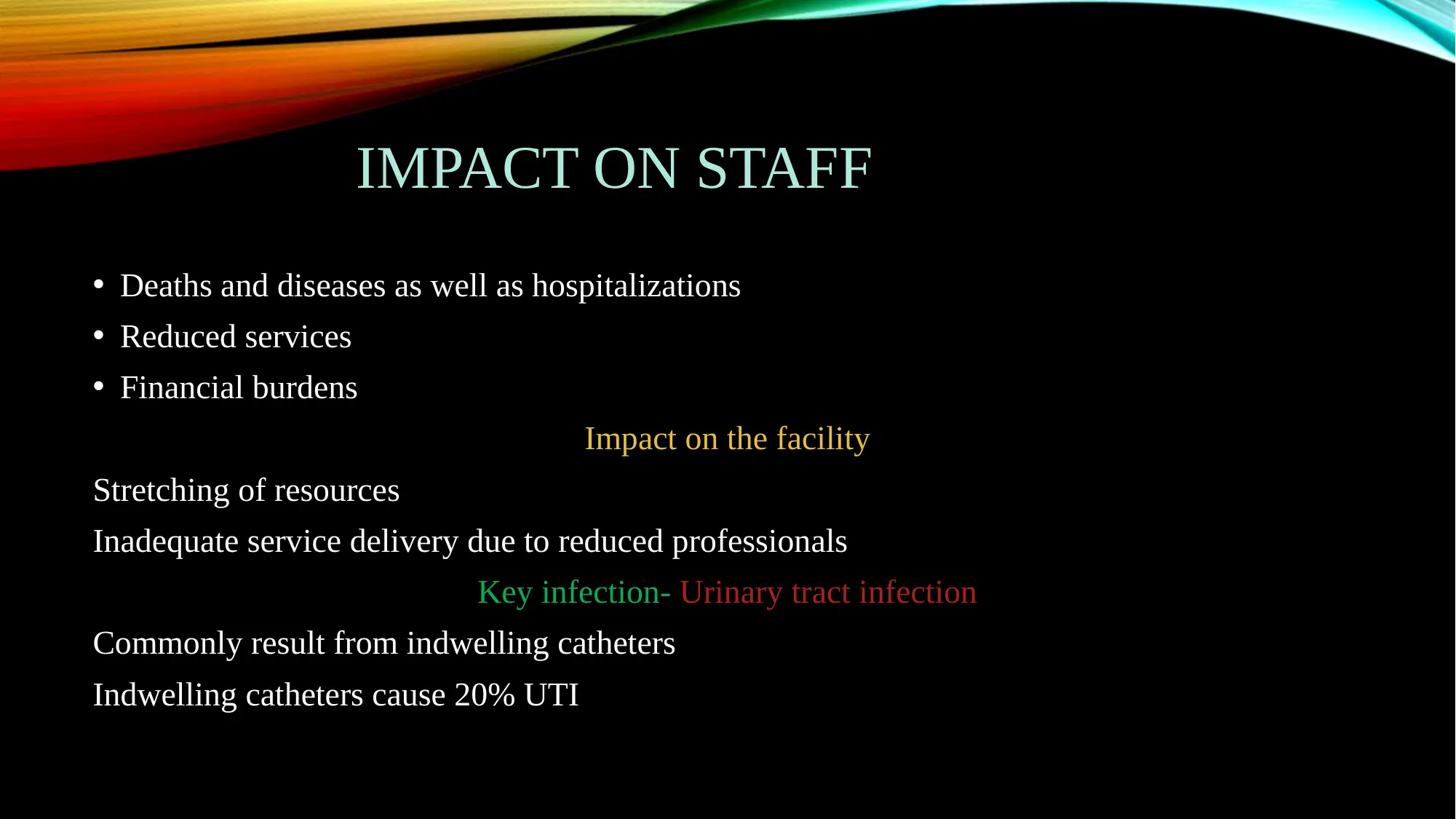
IMPACT ON STAFF
• Deaths and diseases as well as hospitalizations
• Reduced services
• Financial burdens
Impact on the facility
Stretching of resources
Inadequate service delivery due to reduced professionals
Key infection- Urinary tract infection
Commonly result from indwelling catheters
Indwelling catheters cause 20% UTI
• Deaths and diseases as well as hospitalizations
• Reduced services
• Financial burdens
Impact on the facility
Stretching of resources
Inadequate service delivery due to reduced professionals
Key infection- Urinary tract infection
Commonly result from indwelling catheters
Indwelling catheters cause 20% UTI
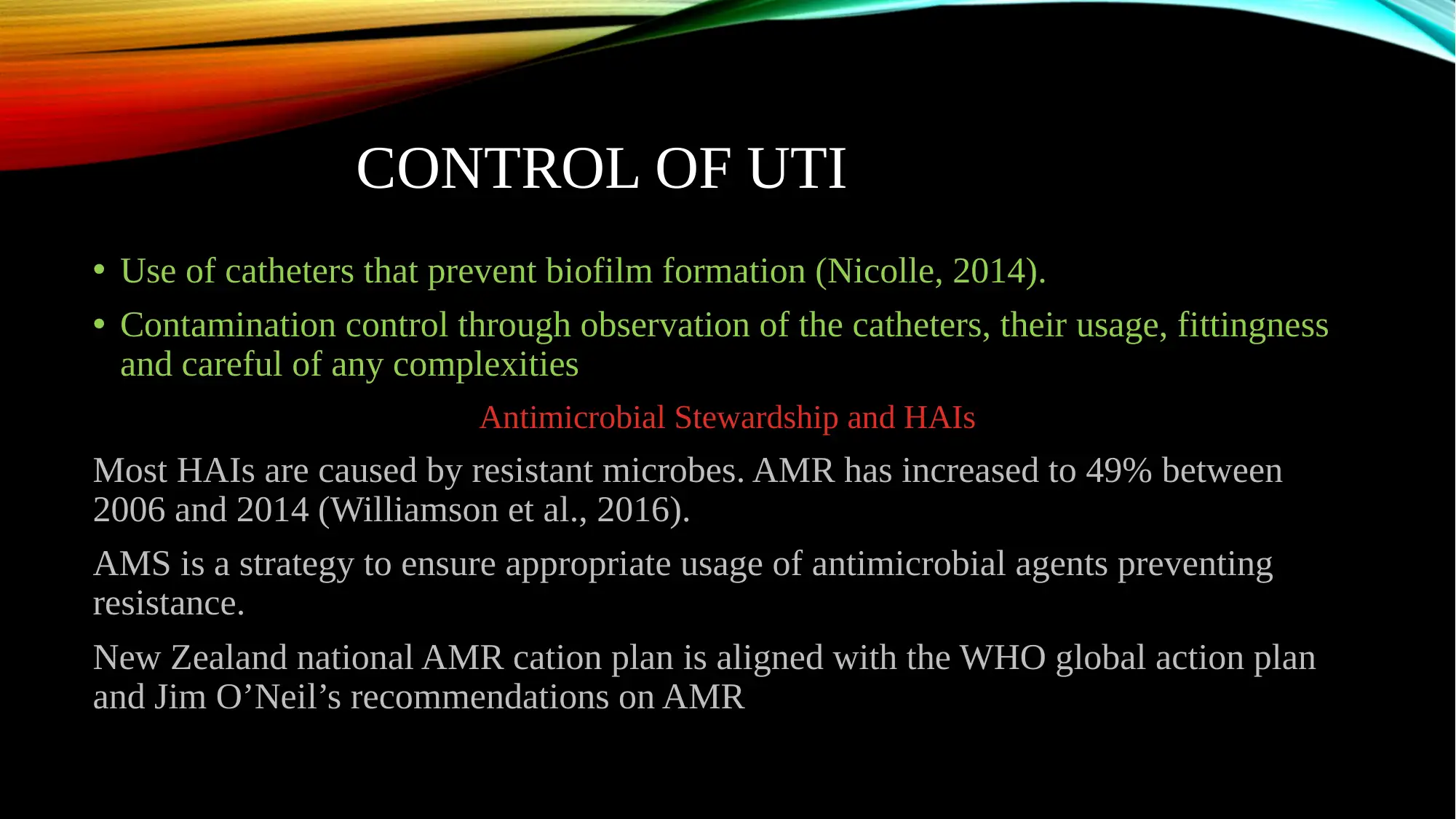
CONTROL OF UTI
• Use of catheters that prevent biofilm formation (Nicolle, 2014).
• Contamination control through observation of the catheters, their usage, fittingness
and careful of any complexities
Antimicrobial Stewardship and HAIs
Most HAIs are caused by resistant microbes. AMR has increased to 49% between
2006 and 2014 (Williamson et al., 2016).
AMS is a strategy to ensure appropriate usage of antimicrobial agents preventing
resistance.
New Zealand national AMR cation plan is aligned with the WHO global action plan
and Jim O’Neil’s recommendations on AMR
• Use of catheters that prevent biofilm formation (Nicolle, 2014).
• Contamination control through observation of the catheters, their usage, fittingness
and careful of any complexities
Antimicrobial Stewardship and HAIs
Most HAIs are caused by resistant microbes. AMR has increased to 49% between
2006 and 2014 (Williamson et al., 2016).
AMS is a strategy to ensure appropriate usage of antimicrobial agents preventing
resistance.
New Zealand national AMR cation plan is aligned with the WHO global action plan
and Jim O’Neil’s recommendations on AMR
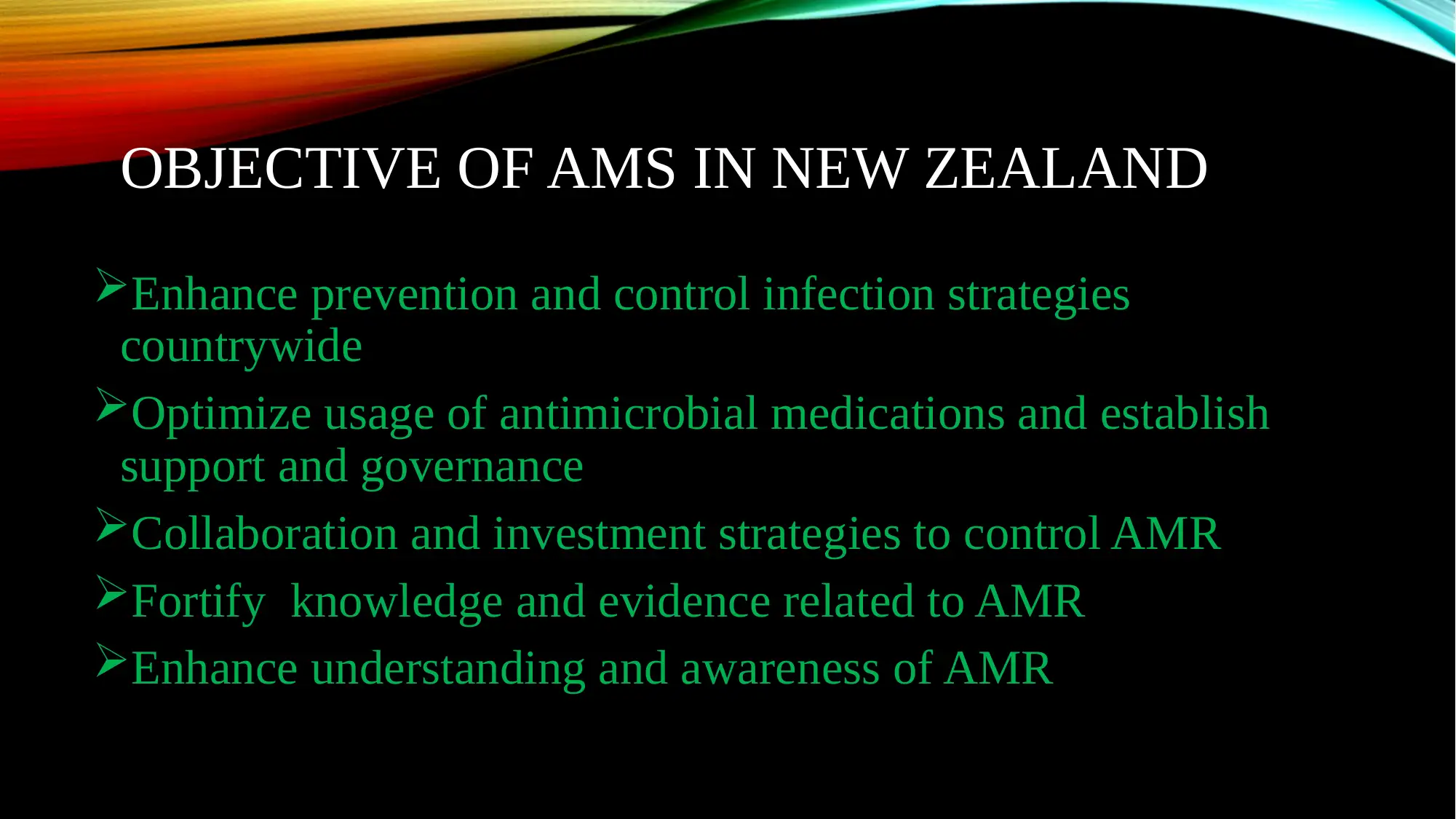
OBJECTIVE OF AMS IN NEW ZEALAND
Enhance prevention and control infection strategies
countrywide
Optimize usage of antimicrobial medications and establish
support and governance
Collaboration and investment strategies to control AMR
Fortify knowledge and evidence related to AMR
Enhance understanding and awareness of AMR
Enhance prevention and control infection strategies
countrywide
Optimize usage of antimicrobial medications and establish
support and governance
Collaboration and investment strategies to control AMR
Fortify knowledge and evidence related to AMR
Enhance understanding and awareness of AMR
Secure Best Marks with AI Grader
Need help grading? Try our AI Grader for instant feedback on your assignments.
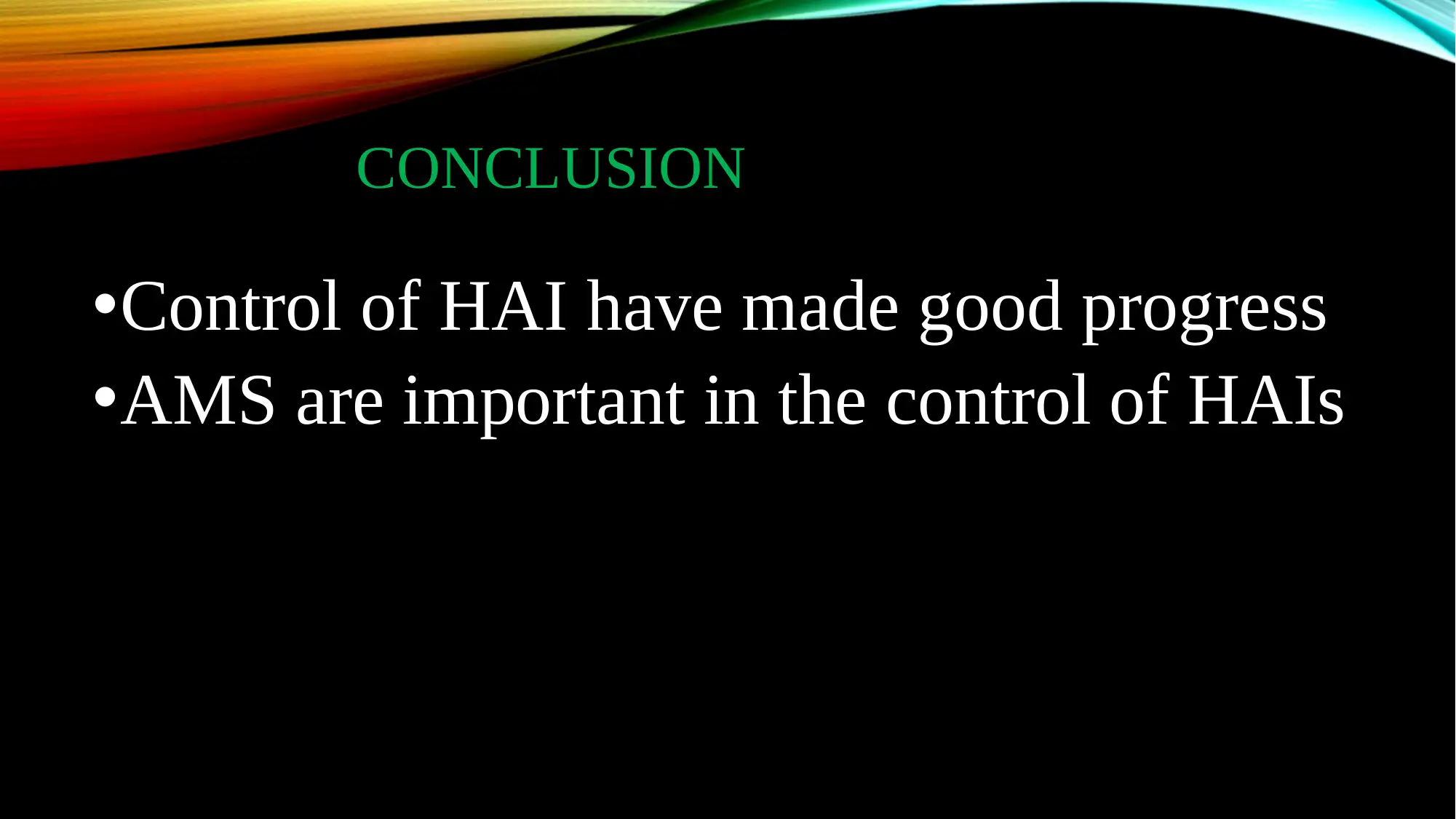
CONCLUSION
•Control of HAI have made good progress
•AMS are important in the control of HAIs
•Control of HAI have made good progress
•AMS are important in the control of HAIs
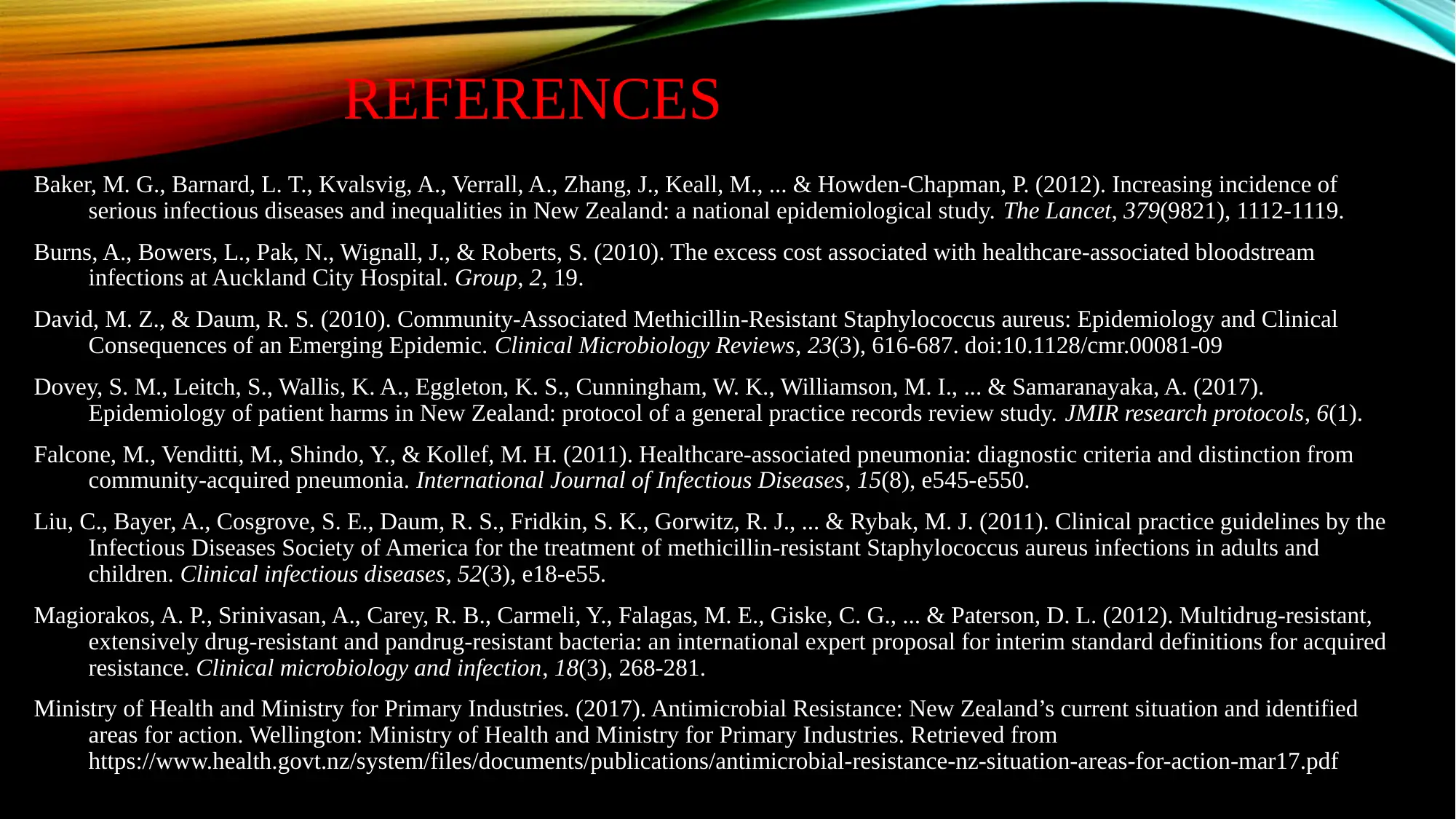
REFERENCES
Baker, M. G., Barnard, L. T., Kvalsvig, A., Verrall, A., Zhang, J., Keall, M., ... & Howden-Chapman, P. (2012). Increasing incidence of
serious infectious diseases and inequalities in New Zealand: a national epidemiological study. The Lancet, 379(9821), 1112-1119.
Burns, A., Bowers, L., Pak, N., Wignall, J., & Roberts, S. (2010). The excess cost associated with healthcare-associated bloodstream
infections at Auckland City Hospital. Group, 2, 19.
David, M. Z., & Daum, R. S. (2010). Community-Associated Methicillin-Resistant Staphylococcus aureus: Epidemiology and Clinical
Consequences of an Emerging Epidemic. Clinical Microbiology Reviews, 23(3), 616-687. doi:10.1128/cmr.00081-09
Dovey, S. M., Leitch, S., Wallis, K. A., Eggleton, K. S., Cunningham, W. K., Williamson, M. I., ... & Samaranayaka, A. (2017).
Epidemiology of patient harms in New Zealand: protocol of a general practice records review study. JMIR research protocols, 6(1).
Falcone, M., Venditti, M., Shindo, Y., & Kollef, M. H. (2011). Healthcare-associated pneumonia: diagnostic criteria and distinction from
community-acquired pneumonia. International Journal of Infectious Diseases, 15(8), e545-e550.
Liu, C., Bayer, A., Cosgrove, S. E., Daum, R. S., Fridkin, S. K., Gorwitz, R. J., ... & Rybak, M. J. (2011). Clinical practice guidelines by the
Infectious Diseases Society of America for the treatment of methicillin-resistant Staphylococcus aureus infections in adults and
children. Clinical infectious diseases, 52(3), e18-e55.
Magiorakos, A. P., Srinivasan, A., Carey, R. B., Carmeli, Y., Falagas, M. E., Giske, C. G., ... & Paterson, D. L. (2012). Multidrug‐resistant,
extensively drug‐resistant and pandrug‐resistant bacteria: an international expert proposal for interim standard definitions for acquired
resistance. Clinical microbiology and infection, 18(3), 268-281.
Ministry of Health and Ministry for Primary Industries. (2017). Antimicrobial Resistance: New Zealand’s current situation and identified
areas for action. Wellington: Ministry of Health and Ministry for Primary Industries. Retrieved from
https://www.health.govt.nz/system/files/documents/publications/antimicrobial-resistance-nz-situation-areas-for-action-mar17.pdf
Baker, M. G., Barnard, L. T., Kvalsvig, A., Verrall, A., Zhang, J., Keall, M., ... & Howden-Chapman, P. (2012). Increasing incidence of
serious infectious diseases and inequalities in New Zealand: a national epidemiological study. The Lancet, 379(9821), 1112-1119.
Burns, A., Bowers, L., Pak, N., Wignall, J., & Roberts, S. (2010). The excess cost associated with healthcare-associated bloodstream
infections at Auckland City Hospital. Group, 2, 19.
David, M. Z., & Daum, R. S. (2010). Community-Associated Methicillin-Resistant Staphylococcus aureus: Epidemiology and Clinical
Consequences of an Emerging Epidemic. Clinical Microbiology Reviews, 23(3), 616-687. doi:10.1128/cmr.00081-09
Dovey, S. M., Leitch, S., Wallis, K. A., Eggleton, K. S., Cunningham, W. K., Williamson, M. I., ... & Samaranayaka, A. (2017).
Epidemiology of patient harms in New Zealand: protocol of a general practice records review study. JMIR research protocols, 6(1).
Falcone, M., Venditti, M., Shindo, Y., & Kollef, M. H. (2011). Healthcare-associated pneumonia: diagnostic criteria and distinction from
community-acquired pneumonia. International Journal of Infectious Diseases, 15(8), e545-e550.
Liu, C., Bayer, A., Cosgrove, S. E., Daum, R. S., Fridkin, S. K., Gorwitz, R. J., ... & Rybak, M. J. (2011). Clinical practice guidelines by the
Infectious Diseases Society of America for the treatment of methicillin-resistant Staphylococcus aureus infections in adults and
children. Clinical infectious diseases, 52(3), e18-e55.
Magiorakos, A. P., Srinivasan, A., Carey, R. B., Carmeli, Y., Falagas, M. E., Giske, C. G., ... & Paterson, D. L. (2012). Multidrug‐resistant,
extensively drug‐resistant and pandrug‐resistant bacteria: an international expert proposal for interim standard definitions for acquired
resistance. Clinical microbiology and infection, 18(3), 268-281.
Ministry of Health and Ministry for Primary Industries. (2017). Antimicrobial Resistance: New Zealand’s current situation and identified
areas for action. Wellington: Ministry of Health and Ministry for Primary Industries. Retrieved from
https://www.health.govt.nz/system/files/documents/publications/antimicrobial-resistance-nz-situation-areas-for-action-mar17.pdf
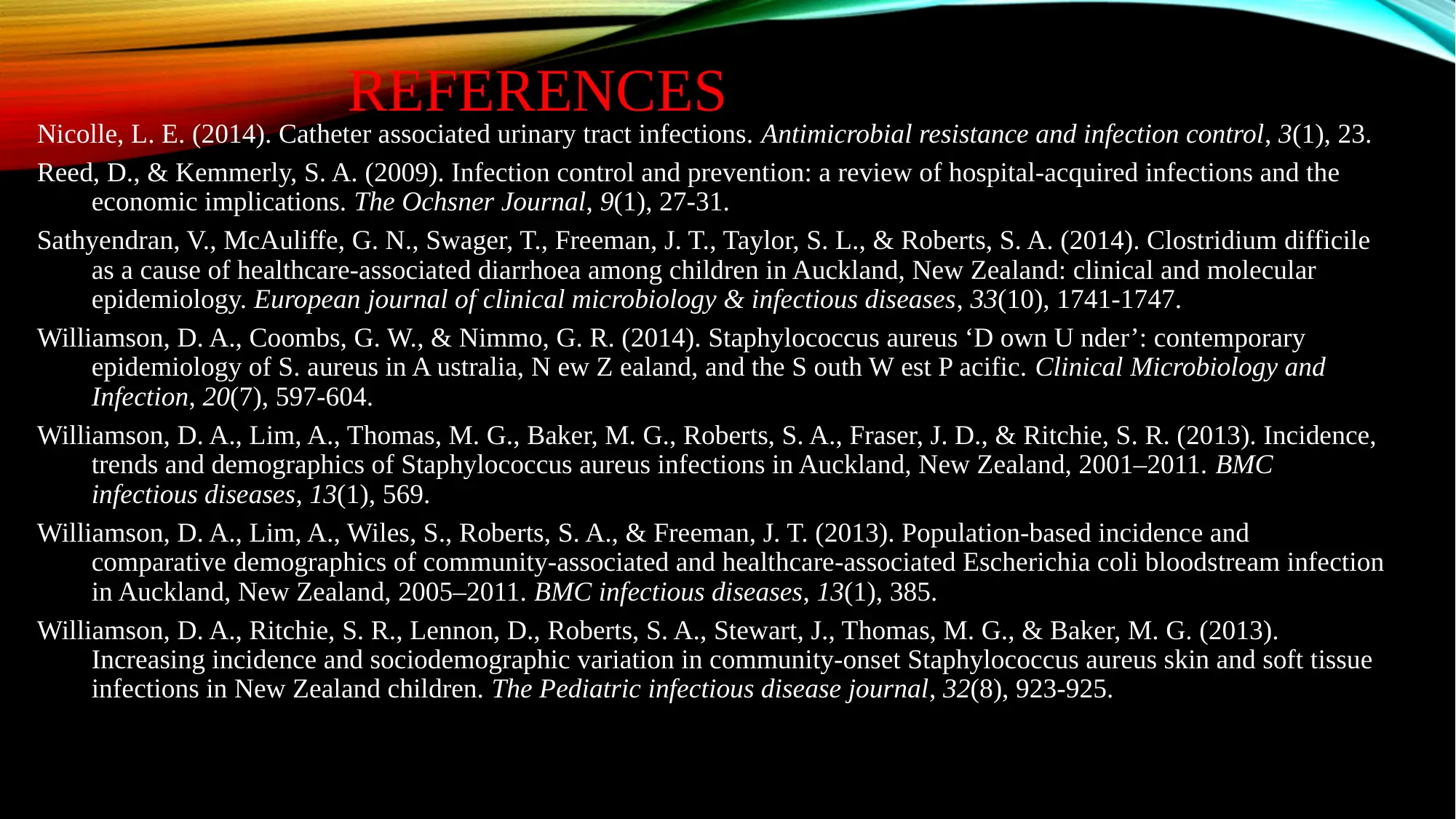
REFERENCES
Nicolle, L. E. (2014). Catheter associated urinary tract infections. Antimicrobial resistance and infection control, 3(1), 23.
Reed, D., & Kemmerly, S. A. (2009). Infection control and prevention: a review of hospital-acquired infections and the
economic implications. The Ochsner Journal, 9(1), 27-31.
Sathyendran, V., McAuliffe, G. N., Swager, T., Freeman, J. T., Taylor, S. L., & Roberts, S. A. (2014). Clostridium difficile
as a cause of healthcare-associated diarrhoea among children in Auckland, New Zealand: clinical and molecular
epidemiology. European journal of clinical microbiology & infectious diseases, 33(10), 1741-1747.
Williamson, D. A., Coombs, G. W., & Nimmo, G. R. (2014). Staphylococcus aureus ‘D own U nder’: contemporary
epidemiology of S. aureus in A ustralia, N ew Z ealand, and the S outh W est P acific. Clinical Microbiology and
Infection, 20(7), 597-604.
Williamson, D. A., Lim, A., Thomas, M. G., Baker, M. G., Roberts, S. A., Fraser, J. D., & Ritchie, S. R. (2013). Incidence,
trends and demographics of Staphylococcus aureus infections in Auckland, New Zealand, 2001–2011. BMC
infectious diseases, 13(1), 569.
Williamson, D. A., Lim, A., Wiles, S., Roberts, S. A., & Freeman, J. T. (2013). Population-based incidence and
comparative demographics of community-associated and healthcare-associated Escherichia coli bloodstream infection
in Auckland, New Zealand, 2005–2011. BMC infectious diseases, 13(1), 385.
Williamson, D. A., Ritchie, S. R., Lennon, D., Roberts, S. A., Stewart, J., Thomas, M. G., & Baker, M. G. (2013).
Increasing incidence and sociodemographic variation in community-onset Staphylococcus aureus skin and soft tissue
infections in New Zealand children. The Pediatric infectious disease journal, 32(8), 923-925.
Nicolle, L. E. (2014). Catheter associated urinary tract infections. Antimicrobial resistance and infection control, 3(1), 23.
Reed, D., & Kemmerly, S. A. (2009). Infection control and prevention: a review of hospital-acquired infections and the
economic implications. The Ochsner Journal, 9(1), 27-31.
Sathyendran, V., McAuliffe, G. N., Swager, T., Freeman, J. T., Taylor, S. L., & Roberts, S. A. (2014). Clostridium difficile
as a cause of healthcare-associated diarrhoea among children in Auckland, New Zealand: clinical and molecular
epidemiology. European journal of clinical microbiology & infectious diseases, 33(10), 1741-1747.
Williamson, D. A., Coombs, G. W., & Nimmo, G. R. (2014). Staphylococcus aureus ‘D own U nder’: contemporary
epidemiology of S. aureus in A ustralia, N ew Z ealand, and the S outh W est P acific. Clinical Microbiology and
Infection, 20(7), 597-604.
Williamson, D. A., Lim, A., Thomas, M. G., Baker, M. G., Roberts, S. A., Fraser, J. D., & Ritchie, S. R. (2013). Incidence,
trends and demographics of Staphylococcus aureus infections in Auckland, New Zealand, 2001–2011. BMC
infectious diseases, 13(1), 569.
Williamson, D. A., Lim, A., Wiles, S., Roberts, S. A., & Freeman, J. T. (2013). Population-based incidence and
comparative demographics of community-associated and healthcare-associated Escherichia coli bloodstream infection
in Auckland, New Zealand, 2005–2011. BMC infectious diseases, 13(1), 385.
Williamson, D. A., Ritchie, S. R., Lennon, D., Roberts, S. A., Stewart, J., Thomas, M. G., & Baker, M. G. (2013).
Increasing incidence and sociodemographic variation in community-onset Staphylococcus aureus skin and soft tissue
infections in New Zealand children. The Pediatric infectious disease journal, 32(8), 923-925.
1 out of 13
Your All-in-One AI-Powered Toolkit for Academic Success.
+13062052269
info@desklib.com
Available 24*7 on WhatsApp / Email
![[object Object]](/_next/static/media/star-bottom.7253800d.svg)
Unlock your academic potential
© 2024 | Zucol Services PVT LTD | All rights reserved.
